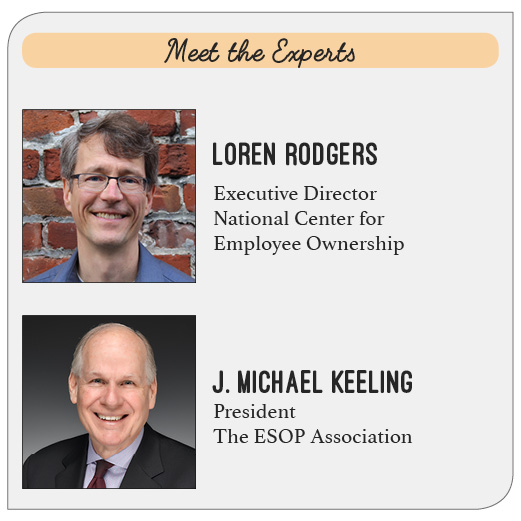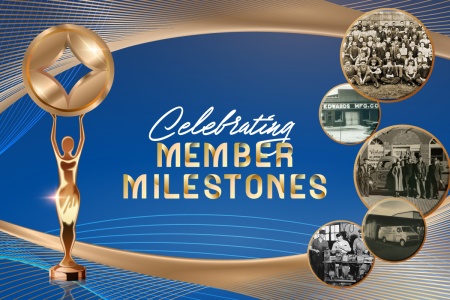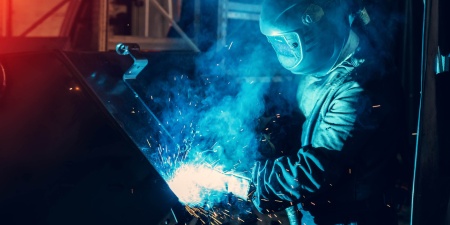For business owners with a succession gap or otherwise at a transitional crossroads, creating an Employee Stock Ownership Plan (ESOP) structure is a business option with work-culture appeal and operating advantages. Restructuring as an ESOP can create a win-win-win solution for the company as well as its stockholders and employees, ESOP advocates say.
Owners who aren’t turning the keys over to a next generation, or selling to an outside buyer, discover that ESOPs may let them “pay it forward.” The format can be the means to continue the company legacy, maintain its culture, secure the jobs of loyal employees and maximize profitability. Instilling an owner mindset among new employee owners, added to the available, built-in tax advantages, are strategies that let owners extract equity while customizing their exit strategies.
Creating an ESOP can present a more palatable way for an owner to exit or retire, rather than liquidating the company or selling to a competitor or an industry conglomerate. Because employee ownership models a participatory culture, it may also help businesses meet some of today’s most pressing human resource challenges — employee recruitment, retention and engagement. The improved company performance that ESOPs can create (boosting productivity, efficiency and revenues from instilling an owner mindset), along with the tax advantages offered, are the cherries on top, advocates say.
A More Palatable Choice
An ESOP can create an attractive transition vehicle, according to Loren Rodgers, executive director of the National Center for Employee Ownership (NCEO). “The actual experience of people who sell to multinationals or private equity firms is that they are often not happy two to three years down the pike. They don’t like what happened to the company, the community that is affected by the sale and their employees and vendors,” he relates.
While selling a company outright may be thought to maximize its price tag, ESOPs can provide high value of a different sort. That depends on what is most important to the selling owner, says Patrick Mirza, director of communications for The ESOP Association. “Typically, when someone sells to an outside interest, they sell the entire company and walk away. When you sell to an ESOP, you can sell piecemeal. You can sell whatever percentage you want. You can spread the sale over time. You can remain in your role for a time if you want. For someone who wants to get out gradually, there’s value in selling to an ESOP.”
Different Kinds of Payback
Owners consider many factors besides cash-in-hand, Mirza adds. “If someone has built something over the course of time and they have an attachment to it, and 
It would have been easy to sell to an outside company, relates Dan Fallon, CEO at GAWDA member company McDantim Inc., which became an ESOP in late 2017. “A number of them would have paid a premium. But we felt the company would have been gone within a year to five years. The people who are with us now really helped build the company and it didn’t seem right to sell it out from under them. We really wanted to create something that protected the employees and rewarded them,” he says.
Evan Smith, president and CEO at GAWDA member company Hypertherm Inc., put it this way: “For founders and family owners looking at choices, they can sell to a strategic buyer or to a financial buyer, or if they’re big enough, do a public offering. All of those involve significant disruption or cultural change. So maybe the biggest benefit to the company [of converting to an ESOP] is the continuity and the ability to maintain its independent long-term focus.” For Hypertherm, he says, “I think the ESOP reaffirms the values of the founders and owners. It seemed the way most critically to continue the culture everyone has known and really values.”
At GAWDA member company Norco Inc., CEO and Chairman Jim Kissler agrees. “When I did what I call a partial liquidation of Norco, that took away the incentive to pick up the phone and call an Air Liquide or a Praxair and sell my company in entirety. This way, I can liquidate the assets of Norco into my family, as well as provide for the continuity of the company.” He said the ESOP, which was undertaken in 2015, also “keeps the Larry Kissler [founder] legacy alive.” As structured, it also provides options for future generations, Jim Kissler explains. “My grandkids may want to participate, or they may not want to. If they don’t, there is a market for their shares. If they want to stay in the business, we’re talking 75 years out, there is a Kissler still in either a minority or majority ownership position.”
Improved Performance
In practical terms, employee ownership generally results in a boost in business performance and improvements in worker outcomes, according to research by Director Joseph R. Blasi, Ed.D., and Associate Director Douglas L. Kruse, Ph.D., of The Rutgers Institute for the Study of Employee Ownership and Profit Sharing. Their research has shown that those enhancements typically include a rise in productivity, a lowering of employee turnover, more stability for the company and more job security for workers.
In a whitepaper developed for Third Way Next (“Having A Stake, Evidence and Implications for Broad-based Employee Stock Ownership and Profit Sharing”), written in concert with Richard B. Freeman, Kruse and Blasi describe those tangible benefits. Their studies using data from the U.S. Government’s General Social Survey have shown results of:
Increased worker pay
Improved workplace performance and company productivity (because the environment incentivizes higher effort, cooperation, information sharing and innovation)
Protected jobs (through stabilizing employment and promoting company survival)
More harmonious workplaces (based on the ESOP culture of business reporting and employee involvement, thus greater corporate transparency and increased worker engagement in operations, job functions and decision-making).
The earlier research by Kruse and Blasi of 1,100 companies between 1988 and 1994 quantified productivity increases specifically. They detailed performance-level differences of those firms after they became ESOPs, as opposed to their pre-ESOP performance levels, as follows:
2.4 percent annual sales growth
2.3 percent annual employment growth
2.3 percent annual growth in sales per employee
4.4 percent average increase in employee productivity.
Kruse notes that while the averaged results take into account that some companies do well as ESOPs and others do not, the ESOP environment itself is conducive to success. “We do find that employee ownership tends to work better in companies with certain cultures, where for employees there is high performance work, participation in decisions, lots of information sharing and good job security, as well as a good family feeling. Sometimes employee ownership can build that up, too, but that is the best environment for it.”
The NCEO’s statistics add further data on how the ESOP environment is a boon to company productivity, while also generating additional wealth for employees, stockholders, the company and the communities where the businesses are located. Its site* reports these figures:
ESOP companies are 25 percent more likely to stay in business
Employees in ESOPs have 2.5 times greater retirement accounts
Employees at ESOPs receive 5 to 12 percent more in wages
Productivity improves by 4 to 5 percent on average at companies in the year the ESOP is adopted
Over a 10-year period, ESOP companies have 25 percent higher job growth than comparable companies without an ESOP
ESOP companies see average yearly post-ESOP improvement in return on assets of + 2.7 percent.
Employee owners were four times less likely to be laid off during the recent recession.
(*www.esopinfo.org/infographics/economic-power-of-employee-ownership.php)
Good for America
Not only is employee ownership linked to generally better company performance for the firms who adopt the format, the advantages of converting to an employee-ownership structure can be valuable to an area’s economy, particularly in stabilizing employment, wages and economic activity, according to Kruse. For instance, research data shows that companies that become ESOPs tend to have fewer layoffs in recessions and greater company stability overall. “We’re not entirely sure why, but it looks like if you’re trying to create an ownership culture, you don’t want to lay people off,” the economist adds.
He points to a proposal now before the New Jersey legislature that could create added tax incentives as a way to prompt more companies to adopt employee ownership. On top of the federal capital gains tax initiatives that are in place, the legislation proposes eliminating state capital gains taxes as well for retiring owners who sell at least 30 percent of the company to an ESOP.
“The idea is there is community stability, to make sure the companies continue, and there isn’t disruption to peoples’ lives from shutting down or shifting resources elsewhere. For the retiring owner, there’s a financial incentive, but there’s also the idea of leaving a legacy and keeping the community stable. Those are some really important incentives,” Kruse adds.
J. Michael Keeling, president of The ESOP Association and the Employee Ownership Foundation, echoes the belief that ESOPs are good for the American economy. While there certainly is no guarantee in the free enterprise system that every ESOP company is going to succeed, he says that in general, the macro data that shows ESOPs providing significant performance “is overwhelming.” Keeling cites studies showing that most well-managed employee-owned companies where average-pay employees have a voice, and where they are respected within the structure also make more profits, have more sales, last longer, are more productive and create more wealth for workers than non-employee-owned companies do. “Most ESOPs are formed by the existing shareholders in companies that are secure and that have a nice track record; they’re not sick puppies, so you look at that factor, too,” he explains.
Tax Advantages
There are distinct tax advantages to forming an ESOP. When an owner sells the company to an ESOP and providing certain requirements (called a 1042 rollover) are met, paying capital gains taxes can be avoided for a number of years, says The ESOP Association’s Mirza. “That has to be factored into the value the owner gets for the company. It’s a key element; it’s a huge factor,” Mirza says.
The NCEO lists these as significant tax advantages ESOPs can enjoy:
Contributions of stock are tax-deductible, providing companies a current cash flow advantage by issuing new shares or treasury shares to the ESOP.
A company can contribute cash on a discretionary basis year-to-year and take a tax deduction for it, whether the contribution is used to buy shares from current owners or to build up a cash reserve in the ESOP for future use.
Sellers in a C Corporation can get a tax deferral. In C Corporations, once the ESOP owns 30 percent of all the shares in the company, the seller can reinvest the proceeds of the sale in other securities and defer any tax on the gain.
In S Corporations, the percentage of ownership held by the ESOP is not subject to income tax at the federal level (and usually the state level as well). That means, for instance, that there is no income tax on 30 percent of the profits of an S Corporation with an ESOP holding 30 percent of the stock, and no income tax at all on the profits of an S Corporation wholly owned by its ESOP. (Note: the ESOP still must get a pro-rata share of any distributions the company makes to owners.)
Dividends are tax-deductible. Reasonable dividends used to repay an ESOP loan, passed through to employees, or reinvested by employees in company stock are tax-deductible.
Employees pay no tax on the contributions to the ESOP, only the distribution of their accounts. Employees can roll over their distributions in an IRA or other retirement plan or pay current tax on the distribution, with any gains accumulated over time taxed as capital gains. The income tax portion of the distributions, however, is subject to a 10 percent penalty if made before normal retirement age.
(For a full explanation of the tax advantages ESOPs can offer, see The ESOP Association’s website at: www.esopassociation.org/, search “Tax Advantages.”)
ESOPs Are Attractive
“At its very simplest, an ESOP is a retirement plan,” Mirza observes. “You can have just the retirement plan with an ESOP and stop there. But, you can offer extra elements that companies are trying to get people to do. You don’t have to, but you can. There’s only one requirement — once a year you have to get an evaluation of the stock, and you have to tell employees what that stock value is. Companies who take this step find that they end up spending a lot of time telling employees how the business runs, how things work. That naturally leads to other things, including employees cutting costs and seeing how these things fit in.”
The employee ownership aspect “is a huge part of our culture, a big part of who we are as a company,” says Ryan Diekow, president and CEO of GAWDA member company Oxygen Service Company.
“I think our total compensation, total package, when you wrap in the ESOP and pay and bonuses, is very, very competitive. It’s certainly above average. I think from a turnover point of view, we have extremely low turnover because of the ESOP. It’s less than 10 percent. If we take retirees out, it is probably below 5 percent. It is a great employee retention tool, for sure.”
Food for Thought for Owners
NCEO’s Rodgers notes that there while there is “major money invested in advertising now to convince owners that the best way to transition out of their business ownership is to sell to a third party,” anyone thinking of converting to an ESOP should take time to research their options and allow sufficient time for a transition to take place if they are thinking of the ESOP route.
It’s wise for owners to carefully consider all available options before taking any action as an exit strategy, The ESOP Association’s Keeling adds. He says owners should examine first whether there are family members to pass the company to, and second, if an interested group of trusted senior managers exists as a potential buyer.
“There are financial issues and psychological issues to satisfy,” he notes, and both sides of the coin deserve thorough consideration. “You clearly have to understand the tax consequences. ESOPs do have a set of special tax incentives and attributes that could perhaps be very attractive. Now to turn to the psychological. You have to ask whether your legacy, your contribution to your community and to the business community you’re in, and to the employees that made the company, is the ESOP going to satisfy those kinds of desires more than anything else you could do?”
Professor Kruse agrees. “As people retire, they don’t want to just sell to an outside investor who may end up shutting the company down or shifting its resources elsewhere. A lot of retiring owners want to leave a legacy and see the people they’ve worked with continue to be employed with the company.”
Keeling adds one point that owners who are considering selling to a private equity or a merger/acquisition interest, or letting a competitor buy them out, should be aware of: the history and motivations of potential buyers. “Over the years, I’ve observed that such options often lead to the layoff of employees, particularly those in the back-office operations. The acquiring company already has people doing those jobs. When you’re looking to acquire, you’re looking to get the profit line as high as possible. Generally the biggest place to increase profit is to get the compensation line lowered.”
Keeling urges owners to keep in mind “what you and your partner or family feel comfortable with” as an outcome. “Chances are high that you’ll be involved in the same community in your retirement. Most people have connections, and they’ll be thinking about the repercussions, so think those through.”
Take Time for Research, Due Diligence
It’s also important to shop for quality service providers and to conduct due diligence to be sure those selected will properly guide the company’s transition, NCEO’s Rodgers says. In general, ESOP transitions “work out very well for the average ESOP company. But, it can go wrong. So, it’s good to take the time and put in the care to be sure to do it right,” he advises. As a source of information and a conduit to other ESOPs and owners, the NCEO is willing to connect owners with service firms as well as companies who have had satisfying experiences becoming ESOPs, Rodgers offers.
He suggests other key steps for those considering becoming an ESOP:
First (and especially if there is more than one owner), search your heart to see what’s important as an outcome. Think about what you want to look back on and what kind of outcome you want.
Take sufficient time for the process — six months or so at minimum.
An even longer timeline provides more time for an orderly transition and the advantage of “being ready for the human side,” Rodgers says. That timeframe lets you “announce this to the workforce in a way that sets things up for success. It pays to be really thoughtful, not just about the transaction, but how to portray the transaction to the workforce initially.”
Owners should prepare for varied employee reactions (from thinking they’ll get rich quick, to being scared that the founder is leaving altogether, to the belief that the company is going right out of business).
Despite good planning and plenty of time, converting ownership to the employees can come with some unexpected results, Rodgers says. “The biggest surprise some companies face is there are two distinct phases in the life of an ESOP,” that of before and after, he explains. “Most of the surprises that people face are not inherent. They usually are the result of focusing too much on the transaction and not enough on the longer term.”
There Are Cons, Too
As positive an option as employee ownership appears to be, some cons exist, according to Rutgers’ Kruse. They include the format being subject to “the free-rider problem,” where “rewards from individual effort are shared with other workers and the direct incentive to work hard may be weak.” Also a consideration is the fact that, “the effectiveness of employee ownership may depend on a complicated combination of supportive policies, such as employee involvement, job security and training.” A third reason for some doubt is that employees “can be exposed to excessive financial risk, especially when employee ownership is a large share of a worker’s wealth, and when it substitutes for other pay and benefits,” Kruse writes.
Some of those issues may be offset by the employee-ownership environment itself, according to Craig Wood, CEO of GAWDA member company O.E. Meyer Co. “Being an ESOP has created a tremendous amount of stability and peer pressure at all levels of the company. If a guy isn’t doing his job and needs to pick it up, the other employees will tell him. They feel the value of that ownership,” he describes.
The Potential for Broadened Wealth
While transitioning owners are certainly looking out for their own interests and for the future of their organization, the path to becoming an ESOP is one that can benefit more than just those with immediate connections to the new ESOP, according to Douglas Kruse. Those who advocate for employee ownership, or as it is sometimes referenced, shared capitalism, feel that the concept is good for the American economy and for any system of democracy, he says.
“There really is a lot of positive potential in employee ownership, and a lot of people don’t realize that. The economy hasn’t given enough consideration to employees having direct stakes in the companies and in the success of the companies,” he adds.
The broad distribution of ownership is something that the founding fathers were keen on, and an idea with deep roots in American tradition, Kruse notes. He says that, as an economist, he is, “concerned about the growing inequality in our country of wealth and income, and this can be a good way to distribute the economic rewards of our system more broadly.” That premise is detailed in the book that he, Blasi and Freeman published in 2014, “The Citizen’s Share: Putting Ownership Back into Democracy.”
“The [Founders] thought it was very important for democracy, and I think there’s a lot to that. It’s hard to have a functioning democracy if just a tiny bit of the people own everything. So, employee ownership can be part of a broadened ownership policy from a political perspective,” says Kruse.









